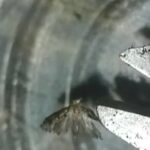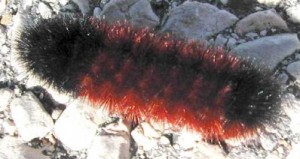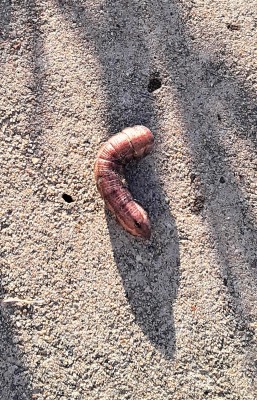A couple wrote to us about a “worm” they found that might be of interest to their grandchildren. (Actually, they said their “G-Kids,” which we presume to be grandchildren, although GKIDS is also an acronym for a few different things, muddying the situation.) The readers were right to put the word “worm” in quotation marks, as the creature they found is not a worm, but rather a caterpillar. Indeed, we are fairly certain it is a Tiger Swallowtail caterpillar. Below is some basic information about the Tiger Swallowtail caterpillar, along with a nice picture of the caterpillar submitted by the readers.
First, the picture:
The first thing you might notice about this creature (other than the fact that it is in a bag – readers, we urge you to make sure this bag is well ventilated, and to release the caterpillar back into the wild once the G-Kids have checked it out) is that it appears to have eyes. These are actually not eyes, however, but rather eyespots. Eyespots are a common defense mechanism used by caterpillars to scare off potential predators – like, say, birds – that might be tempted to eat them. Lots of species of caterpillars have eyespots, including Tiger Swallowtail caterpillars. Why else do we think our reader found this type of caterpillar? Well, because the creature our reader found looks exactly like a Tiger Swallowtail caterpillar, a fact that can be confirmed by either searching for images of this caterpillar, or checking out another article we recently wrote about Tiger Swallowtail caterpillars that includes a picture of them.
So, operating on the very likely assumption that our reader did find a Tiger Swallowtail caterpillar, there are a few more things to say about this creature. First, there are actually two different species of Tiger Swallowtail caterpillar. One is the Western Tiger Swallowtail caterpillar (Papilio rutulus), the other is the Eastern Tiger Swallowtail caterpillar (Papilio glaucus). These names are not arbitrary, as the former species is most prevalent in the Western United States and the latter is most prevalent in the Eastern United States. Since our reader is from North Carolina, it’s likely they found the Eastern Tiger Swallowtail caterpillar, which is actually one of the most familiar caterpillars in this part of the country. (Or at least the butterflies that the caterpillars turn into are quite familiar – maybe the caterpillars aren’t observed quite as much.)
The particular caterpillar our reader found is likely in one of the first three instars of the creature’s development. (Instars are stages of development in between each molt that occur before the creature reaches sexual maturity.) The caterpillar is brown during these instars, and then during the fourth it takes on a vibrant green color. Right before it pupates, however, it turns brown again, so it’s also possible that this is the stage of the caterpillar’s development. In any case, it’s obviously in the larval developmental stage, moving toward its eventual evolution into a butterfly.
It is perhaps worth mentioning that the Easter Tiger Swallowtail Caterpillar can’t be distinguished from two other types of caterpillars that also belong to the Papilio genus, namely, the Papilio canadensis (Canadian Tiger Swallowtail) and the Papilio appalachiensis (Appalachian Tiger Swallowtail), but for reasons of geography it is most likely they found the Eastern Tiger Swallowtail caterpillar. Regardless, we’re virtually certain they found a Tiger Swallowtail caterpillar, and that’s probably enough for our readers. We hope the G-Kids like the caterpillar!
All About Worms is always free, always reader-supported. Your tips via CashApp, Venmo, or Paypal are appreciated! Receipts will come from ISIPP Publishing.

















